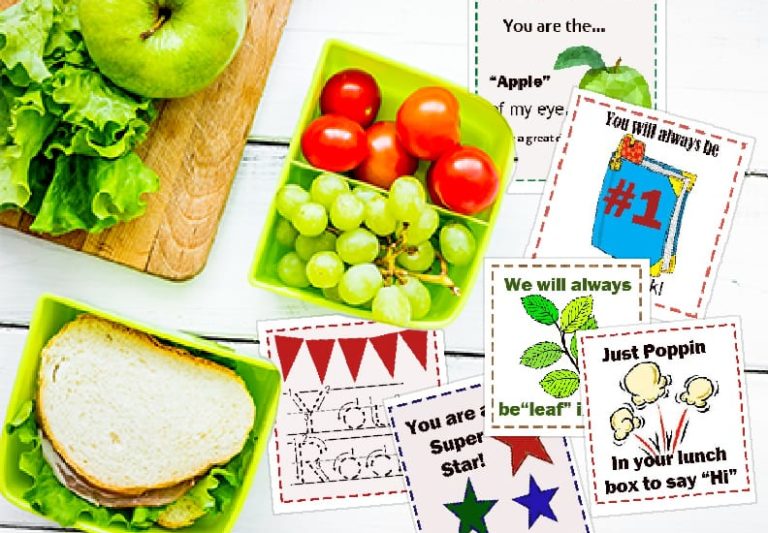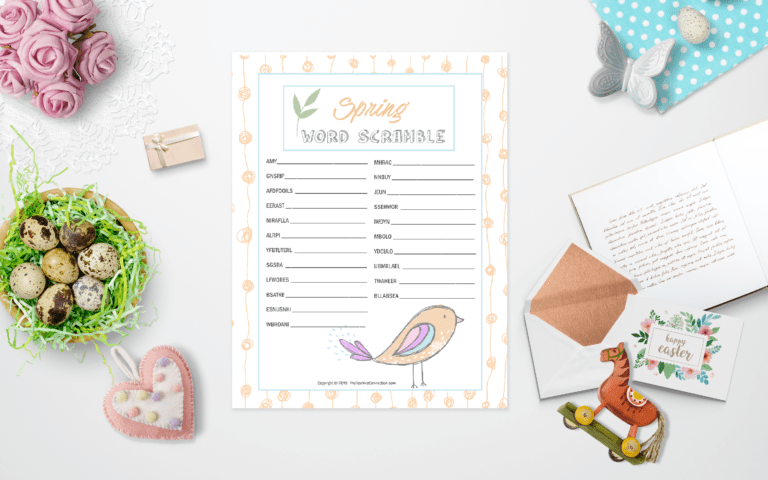Cutting Practice Worksheets for Kids – Free Printables to Boost Fine Motor Skills
Disclosure: This post may contain affiliate links, meaning I may get a small commission if you decide to make a purchase through my links, at no cost to you.
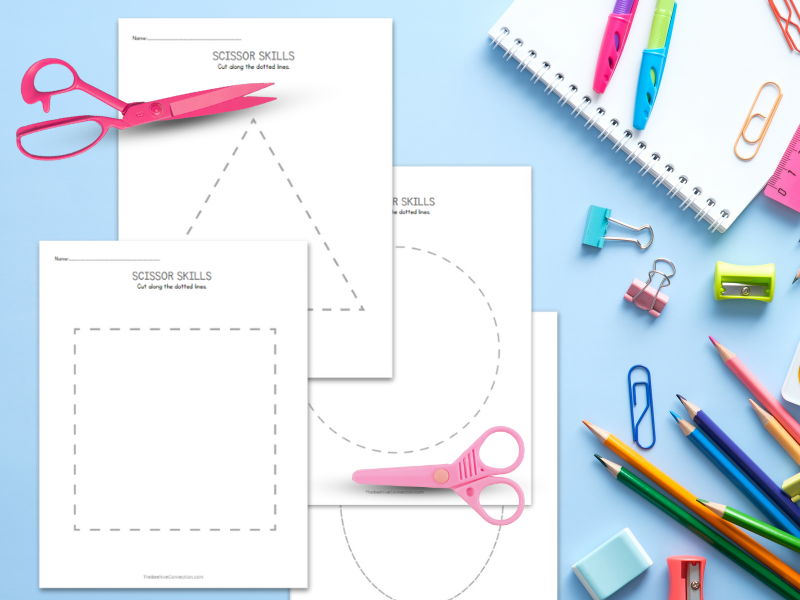
Being in the world of early education, I have seen the pivotal role of Cutting Practice Worksheets. These tools are not just paper and scissors; they’re stepping stones my young learners to build essential skills.
As educators and parents, understanding how these cutting practice worksheets contribute to child development is key. From enhancing fine motor skills to fostering hand-eye coordination, this post unpacks it all.
We’ll dive deep into different types of cutting practice worksheets that cater to every learning stage—starting with simple lines and then advancing to complex shapes.
But we won’t stop there. Explore engaging games that elevate cutting abilities, moving past the usual worksheet exercises.
For those on the lookout for resources, get ready! We’ve got free printable options perfect for home or classroom use.
Together, let’s dive into creating tailor-made cutting practice worksheets that cater to each young learner’s unique requirements, ensuring the process remains both captivating and fruitful.
Table Of Contents:
- The Essential Role of Cutting Practice Worksheets in Early Education
- Types of Cutting Worksheets That Enhance Learning
- Integrating Fun into Scissor Skills Development
- Free Resources for Enhancing Cutting Practice at Home or School
- Maximizing the Benefits of Scissor Skill Bundles
- Creative Ways to Teach Kids Fine Motor Skills
- The Importance of Hand Strength in Developing Scissors Skills
- Customizing Cutting Activities for Individual Needs
- Straight Line Cutting Practice: A Scissor Skill Adventure!
- FAQs in Relation to Cutting Practice Worksheets
- Conclusion
The Essential Role of Cutting Practice Worksheets in Early Education
Picture this: I have a group of preschoolers, scissors in hand, concentrating hard on cutting along dotted lines. At first glance, I think it is mere play, yet beneath the surface lies a crucial process of skill enhancement.
Between preschool and kindergarten is the prime time for kids to start honing their scissor skills, thanks to their developing fine motor abilities.
And what better way to guide them than with cutting practice worksheets? Far from being mere paper, these worksheets emerge as critical instruments in nurturing fine motor skills, but it also sharpens the synergy between hand and eye coordination, alongside refining their adeptness with scissors.
Download our FREE cutting worksheets here —> Cutting Practice Worksheets
Benefits of Cutting Practice
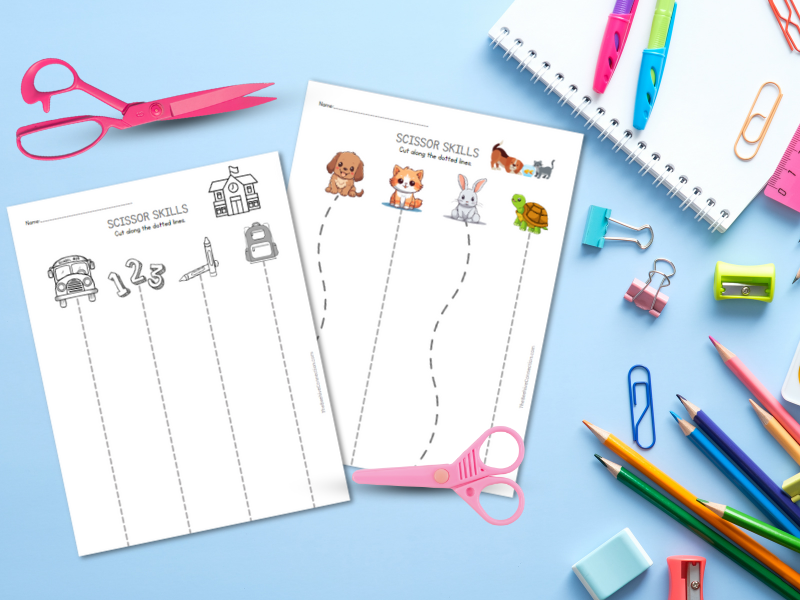
Cutting exercises are crucial for child development – no ifs or buts about it. As children navigate their scissors across the page, they’re not just producing artistic works; they’re fortifying muscles vital for writing, typing, and various indispensable activities in life.
Plus, mastering the open-close motion of scissors boosts hand-eye coordination—a key player in academic success down the line.
But let’s get real—keeping young learners engaged can be as challenging as herding cats. That’s where cutting practice worksheets shine by making learning both fun and productive.
From snipping straight lines to navigating curves around adorable animal figures, these activities keep boredom at bay while reinforcing valuable educational foundations.
Incorporating these cutting practice worksheets into daily learning routines ensures that every cut made strengthens not just dexterity but confidence too.
So next time you see kids getting busy with scissors and paper think of it less as crafting time—and more like brain training.
Related:
Crafts for Kids – Butterfly Fairy Wand
Types of Cutting Worksheets That Enhance Learning
If you think cutting worksheets are just about snipping paper, think again. They’re the unsung heroes in the quest for fine motor skills and scissor mastery.
Ranging from straightforward line slicing to crafting intricate animal figures, these instruments adapt to diverse educational phases and tastes.
Starting Simple with Line Cutting Worksheets
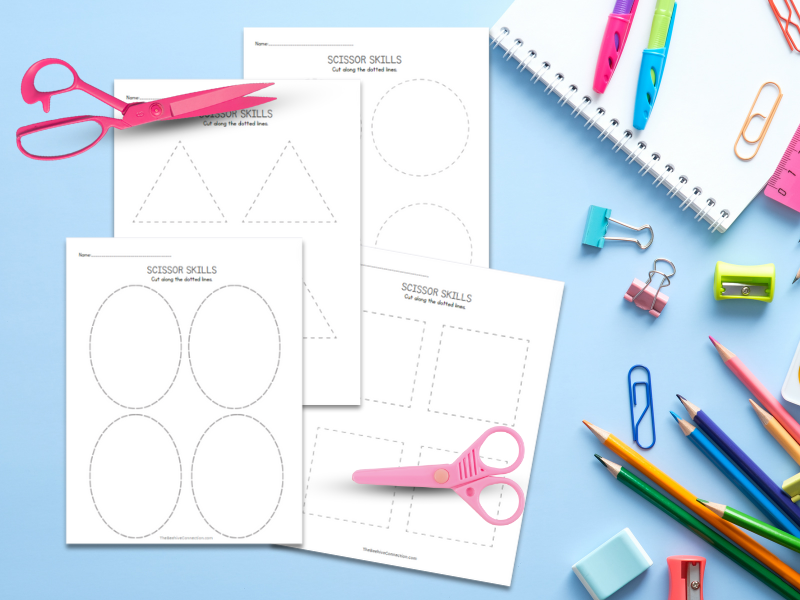
Imagine a world where every beginner starts with a victory. That’s what line cutting worksheets offer. They help kids focus on opening and closing their scissors without worrying about following complex patterns.
Mastering this elementary phase is pivotal, as it establishes the groundwork for tackling more elaborate challenges in the future.
The beauty of starting simple lies in its ability to boost confidence among young learners while enhancing their hand-eye coordination gradually but effectively.
Download our FREE cutting worksheets here —> Cutting Practice Worksheets
Advancing Skills with Shape Cutting Worksheets
Moving up from straight lines to geometric figures, shape-cutting activities introduce kids to detailed figures that require precision and patience.
Far from merely tracing dotted paths, these tasks beckon young minds on an exploratory journey where every slice crafts not just paper but also nurtures the burgeoning realms of their creativity.
This progression isn’t merely by chance—it’s designed meticulously so children can navigate through different levels at their own pace while enjoying every moment of discovery along the way.
Integrating Fun into Scissor Skills Development
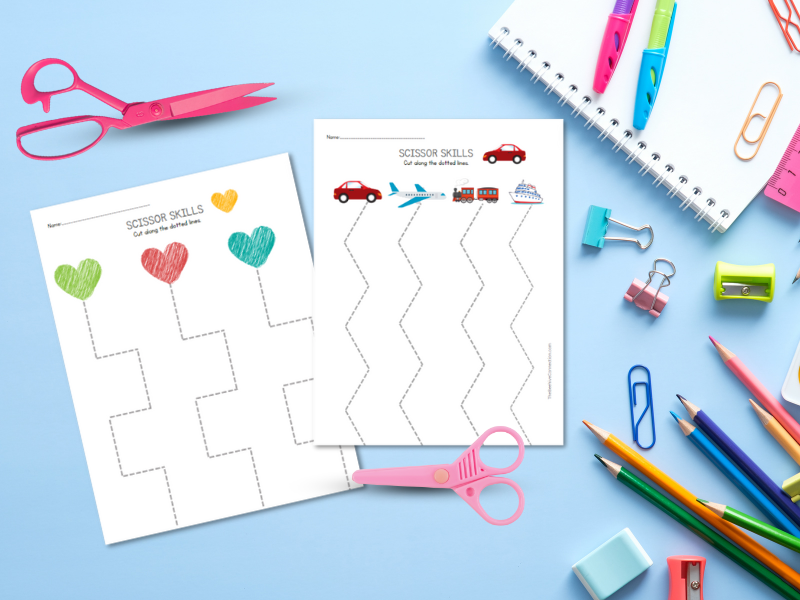
If you think cutting practice worksheets are the only way to boost your little one’s scissor skills, think again. Imagine turning a mundane task into an adventure where every snip is a quest and every cut shapes the world. Blending amusement with education transforms routine learning into an exhilarating journey.
Let’s not forget that engaging in crafts and games does more than just teach kids how to use scissors; it builds hand strength and coordination too. Think about it—when was the last time threading beads or stacking LEGO bricks felt like work?
These activities are power-ups for their fine motor skills, providing essential training without them even realizing they’re practicing.
Download our FREE cutting worksheets here —> Cutting Practice Worksheets
Crafting as a Pathway to Improved Scissor Skills
Through crafting, kids hone their cutting skills in a playful manner that unleashes their creativity. By combining traditional worksheet practices with crafting projects, such as making Christmas crafts or animal figures, kids can apply what they’ve learned on paper to real-world scenarios.
Through this immersive method, kids are not just honing their accuracy but also unleashing their creative spirit—a perfect blend of talents coming to life.
And who knew that those tiny muscles working overtime while threading beads or piecing together LEGO sets were secretly champions at enhancing hand strength?
Incorporating these fun activities into your child’s routine promises an exciting twist on scissor skills development. Transforming everyday drills into moments of anticipation showcases, yet again, the delightful truth that education can indeed be both enjoyable and fruitful at the same time.
Free Resources for Enhancing Cutting Practice at Home or School
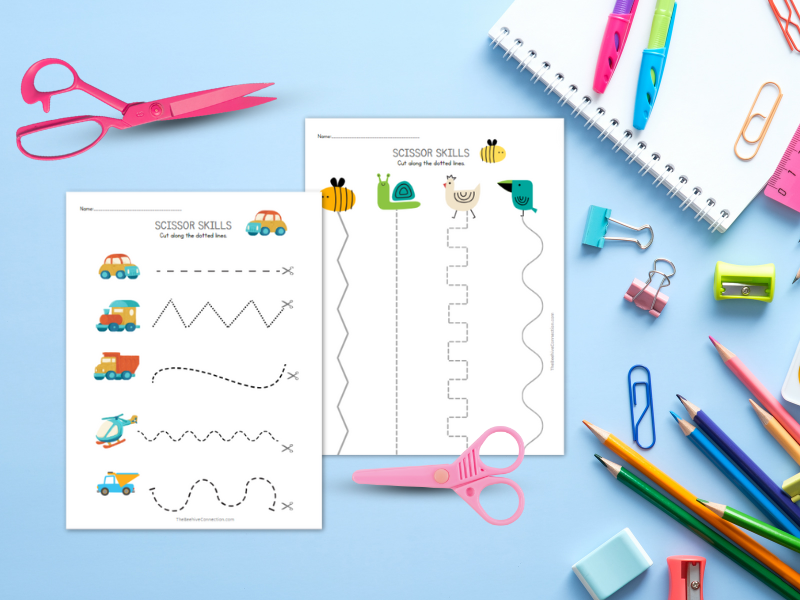
Finding the right resources to help kids develop scissor skills can be as tricky as cutting a straight line with dull scissors. But, fear not. We’ve scoured the internet to give you free printable cutting practice worksheets that are nothing short of amazing.
To kick things off, we’ve unearthed a bounty brimming with choices that transcend the ordinary snip-and-stick activities you might expect. Imagine everything from simple lines and fine motor skill sheets to complex animal cutting adventures.
It’s like hitting the jackpot for anyone looking to boost their little one’s hand strength and precision without breaking the bank.
Then there’s this goldmine, an absolute must-visit for educators and parents alike seeking top-notch materials online.
Whether it’s preschool cut-outs or kindergarten math worksheets disguised as fun activities, this site ensures no child feels left behind in developing those crucial fine motor abilities.
Download our FREE cutting worksheets here —> Cutting Practice Worksheets
Maximizing the Benefits of Scissor Skill Bundles
If you think scissors are just for cutting coupons and opening stubborn chip bags, prepare to be amazed.
The Scissor Skills Bundle is here to transform those ordinary kitchen tools into an educational powerhouse for your little ones.
Dive into the Scissor Skills Bundle, where it’s not only about honing edges but also broadening minds.
Why Additional Resources Like the Scissor Skills Bundle Matter
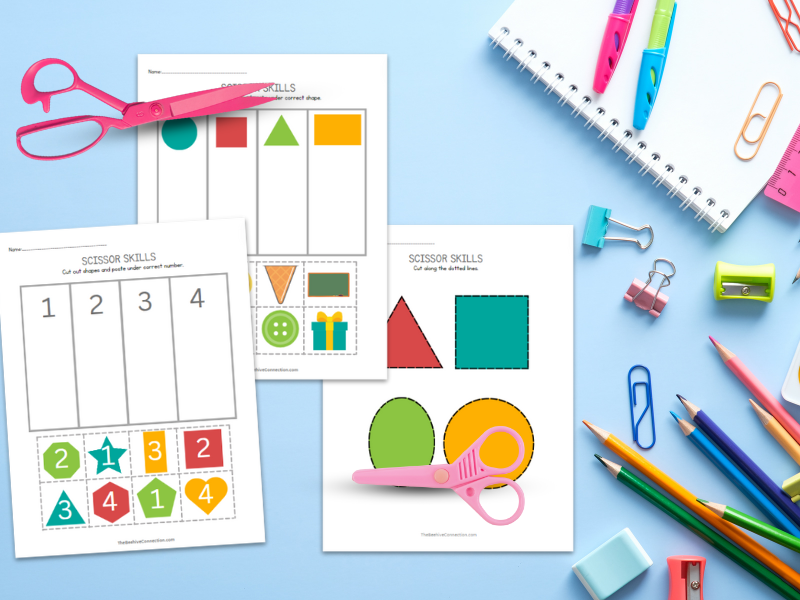
Sure, free printable worksheets are great for practice, but when it comes to scissor skills development, variety is key. Think about it: kids get bored faster than a cat loses interest in a toy mouse that doesn’t move.
That’s where additional resources such as the Scissor Skills Bundle come into play by providing more opportunities for scissor skill practice through engaging activities that keep learning fresh and exciting.
Our handpicked set offers more than mere snipping exercises or basic paths; it delves into creative journeys that transform sheets of paper into masterpieces, all the while honing fine motor abilities. It’s like upgrading from training wheels to a mountain bike — suddenly there’s so much more they can do.
The best part? These bundles aren’t just heaps of paperwork waiting to clutter your dining table (because let’s face it, who needs more of that?).
They’re designed with busy families in mind—easy to use and even easier to clean up after. Plus, watching your child master those snips and cuts without turning their craft project into confetti? Priceless.
The Big Picture: A Snip Above the Rest
Incorporating these comprehensive packages means not only building foundational cutting abilities but also encouraging creativity and precision early on—a combo meal deal if ever there was one. And because every kid marches—or cuts—to the beat of their own drumstick-shaped crayon, having access to diverse materials allows them each to find their rhythm in developing those crucial skills.
Scissor skills bundles turn everyday cutting into a fun, educational adventure, offering diverse activities that keep kids engaged and help fine-tune their motor skills. Perfect for busy families looking to boost creativity without the mess.
Creative Ways to Teach Kids Fine Motor Skills

Forget what you know about traditional fine motor skill activities. Let’s dive into the realm of cutting-edge techniques that transform enhancing those small muscles into an exciting journey for children.
One game-changer in enhancing kids’ fine motor abilities is threading beads. Yes, it’s as simple and as complex as it sounds. Imagine turning a pile of colorful beads and some string into a mini workout session for your child’s fingers. Engaging in this task not only enhances nimbleness but also nurtures the flowering of inventiveness.
Beyond beads, LEGO bricks play a significant role too. Who knew stepping on them wasn’t their only use? When kids snap these blocks together, they’re not just building castles; they’re fortifying their hand strength and precision – essential skills for effective scissor use later on.
Download our FREE cutting worksheets here —> Cutting Practice Worksheets
The Importance of Hand Strength in Developing Scissors Skills
Did you know that the road to becoming a scissor-wielding ninja begins with hand strength? Yes, those little muscles do more than just help us hold onto our ice cream cones. Partaking in certain playful activities greatly enhances the grip power essential for proficiently maneuvering scissors.
Think about it; before kids can cut out shapes or make their first snip, they need the grip and control that only comes from having strong hands. This is where building hand strength through fun activities like threading beads and playing with LEGO blocks comes into play. Engaging in these playful tasks not only captivates the young mind but also lays the groundwork for advanced scissor maneuvers by fortifying dexterity and precision, paving the way for crafting as a conduit to refining those skills.
Customizing Cutting Activities for Individual Needs
Every kid is unique, like a snowflake but without the cold and wet part. So when it comes to developing their fine motor skills with cutting activities, one size does not fit all. That’s why customizing these exercises can make a world of difference in ensuring every child gets to sharpen their scissor skills effectively.
Straight Line Cutting Practice: A Scissor Skill Adventure!

Are you looking for a way to keep your little ones engaged while also boosting their fine motor skills? Look no further than the thrilling world of straight line cutting practice! It’s not just about snipping paper; it’s an adventure where each cut brings them closer to mastering those tricky scissors.
Why Straight Lines?
You might wonder why we’re starting with straight lines. Well, they are the building blocks of scissor skills! Mastering straight lines sets a solid foundation for more complex shapes and patterns. Plus, it gives your kiddos a confidence boost as they see their progress in every neat slice of paper.
Tips for Success:
- Choose the Right Scissors: Make sure the scissors fit comfortably in your child’s hands. Safety scissors with rounded tips are perfect for beginners!
- Paper Matters: Start with thicker paper like construction paper since it’s easier to cut than flimsy printer paper.
- Show and Tell: Demonstrate how to hold and use scissors safely before letting them have a go. Remember, thumb on top!
To get started on this scissor-wielding journey, check out these awesome printable cutting practice worksheets from our friends at FunWithMama: Scissor Practice Cutting Sheets. They’re perfect for practicing those first few cuts without turning your living room into confetti central.
Cutting along straight lines may seem simple but think of it as an art form that requires patience, concentration, and dexterity—skills that will serve well beyond arts and crafts time. So grab some safety scissors, print out those worksheets, and watch as your little one embarks on their path towards becoming a scissor-snipping maestro!
Funny Shapes Galore!
First off, let’s talk about why shapes are so important. Besides being foundational elements of geometry (yawn), they are actually everywhere! From the square windows in our houses to the circular wheels on cars – recognizing these forms is crucial for young minds. But fear not; we’re here to make it as entertaining as slicing through a hot piece of pie.
- The Benefits:
- – Enhances fine motor skills
- – Boosts cognitive recognition
- – Sparks creativity and imagination
- – Promotes hand-eye coordination
To start off this exciting journey, check out some scissors skills activities. It’s packed with ideas that can transform any dull afternoon into an exploration quest!
Crafting Your Way Through Learning
No need to rummage through drawers for activity books; creating your own cutting templates is as easy as pie (and twice as fun!). Grab some colored paper and draw simple shapes: circles, squares, triangles – you name it! For older kids ready for a challenge, intricate designs like stars or even their favorite cartoon characters can add that extra layer of excitement.
Remember parents, while supervising those tiny hands at work, make sure safety comes first by providing child-friendly scissors. And don’t forget—praise goes a long way in keeping motivation high! If crafting isn’t quite hitting the mark or if time just isn’t on your side today, online resources offer printable worksheets tailored specifically towards cutting practice. They’re perfect for squeezing in some quick skill-building between dinner prep and bedtime stories.
So there you have it—a whirlwind tour through shaping up those scissor skills without sacrificing fun or family time. Who knew learning could be such a cut above?
Advanced Cutting Practice Worksheets Motivate Kids to Cut More Carefully Improving Their Precision

To kick things off on the right foot, advanced cutting worksheets are like the secret sauce that makes kids want to try harder. These aren’t your average straight lines; we’re talking zigzags, curves, and shapes that look more complex than a Sunday morning crossword puzzle. But here’s where it gets interesting – as they navigate through tougher patterns, kids develop an eagle eye for detail which boosts their precision big time.
It’s not merely about slicing through material; it involves immersing the youth in a captivating quest they’re eager to dive into with gusto. Think of it as sneaky learning – they’re so focused on conquering those tricky lines and shapes that they don’t even realize how much their skills are leveling up.
Incorporating Various Materials into Craft Projects Encourages Diverse Skills Application
Branching out from paper, we step up the challenge to refine those small hand muscles even more. Imagine swapping out paper for fabric or foam sheets during craft projects – suddenly, what seemed like routine cutting turns into an adventure.
Kids get curious (and excited.) about how different materials react under their scissors’ blades—fabric might need more delicate snips while foam demands firm pressure—teaching them versatility and adaptability along the way. The Scissor Skills Bundle is packed with ideas to introduce this variety seamlessly into your teaching arsenal.
Download our FREE cutting worksheets here —> Cutting Practice Worksheets
Customizing cutting activities and using advanced worksheets boost kids’ precision, turning a simple task into an engaging challenge. Adding different materials like fabric or foam spices up the experience, teaching them adaptability while sharpening their fine motor skills.
FAQs in Relation to Cutting Practice Worksheets
How do you practice cutting skills?
Start with straight lines on paper. Move to shapes, then complex figures. Always supervise and encourage safe scissor use.
What age should kids practice cutting?
Kids usually start practicing cutting around ages 2 to 4, focusing first on simple snips and progressing from there.
What should a 5 year old be able to cut with scissors?
A 5-year-old should manage straight lines, basic shapes like circles or squares, and begin tackling more intricate patterns.
What is the easiest shape to cut?
Straight lines are the simplest for beginners. Next up are basic geometric shapes like squares and rectangles.
Conclusion
Stepping into early education means unlocking potential. Cutting Practice Worksheets are your key. These worksheets go beyond mere cutting exercises; they’re instrumental in developing fine motor skills, enhancing hand-eye coordination, and fostering a plethora of other abilities.
Starting with simple lines moves to shape young minds. Engaging in activities that stretch beyond the mundane worksheets not only enriches learning but ensures every cut is a step toward growth.
Free resources make it easy. From home to classroom, there’s something for everyone. Customizing these activities ensures no child is left behind.
Dive in, explore, and adapt. Each modification carves out a path, transforming education into an exciting and fruitful journey for everyone involved.
The journey doesn’t end here but begins with every worksheet completed—laying the foundation for success one snip at a time.
GET FREE ACCESS TO OUR LIBRARY OF FREE PRINTABLES AND RESOURCES!
Enter Your Name and Email for FREE Access to our Library of FREE Home and Family Printables Series!




